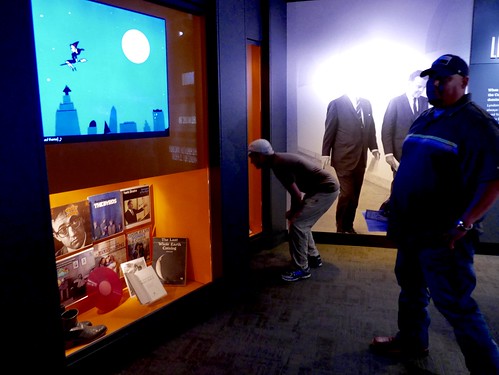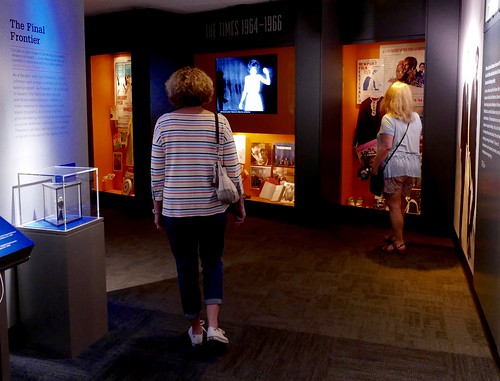

I took these 2 photos on April 13th, when we were in Austin, Texas.
This is not a café post/open thread. I want to discuss the aspects of the 1960s on display here, the aura of creepy entombment, etc.
Strewed over with hurts since 2004
The Jim Crow Museum is the largest publicly accessible collection of segregation and racist artifacts in the United States. These objects are used to teach tolerance and promote social justice. The Museum is free and open to the public; therefore, the Museum is largely dependent on donations-financial and in-kind-to enhance its work.Speaking of contextualizing racist objects reminds me of this scene in "Ghost World," which we were just watching the other day:
"This cross is now a part of the official WTC memorial. No other religions or philosophies will be honored. It will just be a Christian icon, in the middle of OUR memorial,” Dave Silverman, president of American Atheists, said in a release.I think the historic significance of the cross justifies its inclusion in the museum. Human beings cannot construct equivalent monuments for other religions, even if it were, in fact, legally required. Silverman's argument assumes that a historical museum is a free-speech forum that must be open to the speech of all groups, but that's not what a museum is.
Silverman added that the memorial must allow atheists and other belief groups to include their own displays of equal size. For the past several years the cross has been housed at St. Peter's church. On Saturday it was permanently moved to the 9/11 Memorial Museum after a ceremonial blessing at Zuccotti Park. The 9/11 Memorial Museum, which will officially open next year, said its mission is to tell the history of the attacks through artifacts like the cross.
"This steel remnant became a symbol of spiritual comfort for the thousands of recovery workers who toiled at ground zero, as well as for people around the world," said 9/11 Memorial President Joe Daniels. "In the historical exhibition, the cross is part of our commitment to bring back the authentic physical reminders that tell the story of 9/11 in a way nothing else can.”
The installation features a microphone, speakers, and the instructions to visitors: "Scream against the wind/ against the wall/ against the sky" on the far wall. But according to museum employees, the loud, sporadic screams that resulted startled visitors, while staff members strained to speak to museum-goers over the noise. "It was disturbing to the staff at the information desk," said one employee who wished to remain anonymous because MoMA discourages its staff from commenting on artwork or internal affairs.Shame on MoMA! They put Yoko Ono in there in the first place to lure the throngs of people who still pay attention to anything Beatles-related. Then, when the piece had its intended effect of startling and troubling people, they changed it, squelched it, undermining the artists' point to please the lame-oids they lured.
The Ono piece is featured prominently at the entrance to the museum's just-opened "Contemporary Art from the Collection" exhibition, a radical re-installation of its collection that adds nine Ono works. One employee said that the fitful, high-pitched screams caused visitors and even guards to jump with surprise. "Visitors complained," he said.
When Ernest Hemingway and Scott Fitzgerald met in Paris, at Le Dingo Bar on the rue Delambre in April 1925, Hemingway was disconcerted to be asked: "Did you have sex with your wife before you were married, Ernest?" They became friends, however. Their most intimate conversation (as reported by Hemingway) was also about wives. One evening, Scott Fitzgerald confessed to his friend that his wife, Zelda, had told him his penis was unusually small, and that he could never satisfy any woman. Hemingway said it was just typical of Zelda's undermining ways, but Scott wasn't reassured. So Hemingway asked him to come to the lavatory, where he inspected his friend's lance of manhood. Back in the bar, he explained:Oh, I think it's artistic as hell.
"You're perfectly fine," I said. "You're okay. There's nothing wrong with you. You look at yourself from above and you look foreshortened. Go over to the Louvre and look at the people in the statues and then go home and look at yourself in the mirror in profile." Now there was an act of friendship between creative giants, if not an especially artistic conversation.
"You're lovely, but you're empty," he went on. "One couldn't die for you. Of course an ordinary passerby would think my rose looked just like you. But my rose, all on her own, is more important than you altogether, since she's the one I've watered. Since she's the one I put under glass. Since she's the one I sheltered behind a screen. Since she's the one for whom I killed the caterpillars (except for two or three for butterflies). Since's she the one I listened to when she complained, or when she boasted, or even sometimes when she said nothing at all. Since she's my rose."Here's the sculpture that was made out of the loved log:
"With several friends, I transported the tree, cut apart by a chainsaw, back to my Los Angeles studio. Silicone molds were taken and a fiberglass version of the log was reconstructed. This was sent to Osaka, Japan, where master woodworker Yuboku Mukoyoshi and his apprentices carved my vision into reality using Japanese cypress (hinoki).... When I asked Mr. Mukoyoshi about the wood and how it would behave over time, he told me that the wood would be fine for 400 years and then it would go into a crisis; after two hundred years of splitting and cracking, it would go into slow decline for another 400 years. I realized then that the wood, like the original log, had a life of its own, and I was finally able to let my project go and hopefully breathe life into the world that surrounds it."